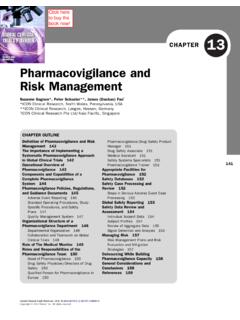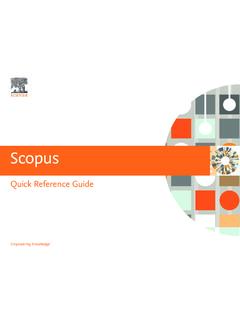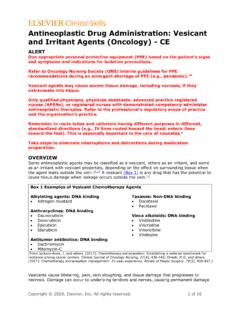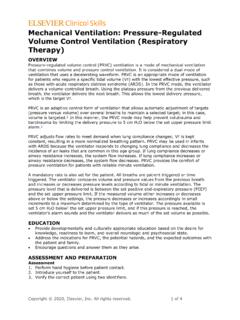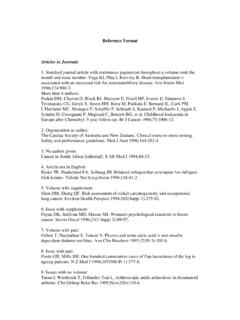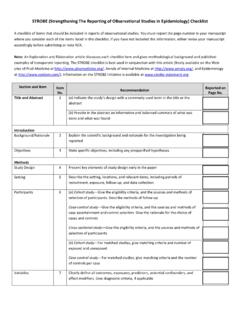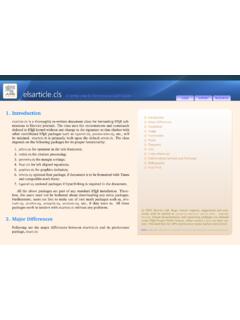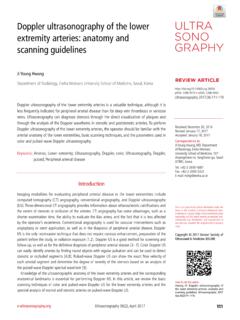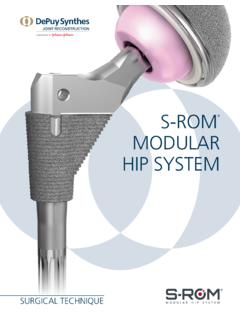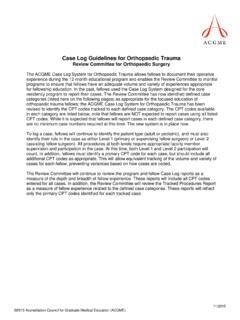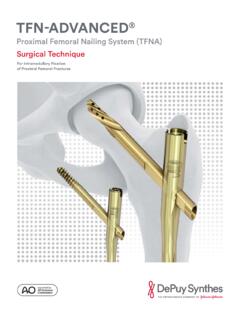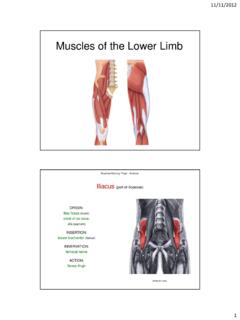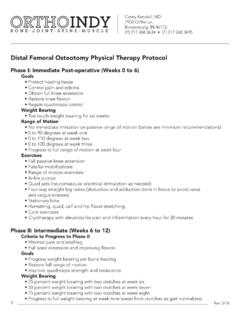Transcription of PROCEDURE Femoral Arterial and Venous Sheath Removal
1 664 Section Ten Special Cardiac Procedures PROCEDURE 76 Femoral Arterial and Venous Sheath Removal Rose B. Shaffer PURPOSE: Arterial and Venous sheaths are placed for cardiac catheterizations and interventional procedures. Achieving and maintaining hemostasis after their Removal is essential to prevent access site complications. PREREQUISITE NURSING KNOWLEDGE Knowledge of the Femoral artery and vein anatomy is important. The technique for the percutaneous approach to the insertion of the Arterial and Venous sheaths should be understood. Technical and clinical competence in Removal of Arterial and Venous sheaths is needed. Knowledge about anticoagulation and antiplatelet therapy used during interventional procedures is essential. Understanding the technology ( , activated clotting time [ACT] machine) used to determine the timing of Arterial Sheath Removal and knowledge of the institution s stan-dards regarding the appropriate ACT level before Arterial Sheath Removal is important.
2 The importance of peripheral vascular and neurovascular assessment of the affected extremity ( , assessment of the quality and strength of the pulse to be accessed and the pulses distal to the access site, assessment for a bruit) should be understood. Knowledge about the variety of hemostasis options avail-able should include the following: Manual compression alone or in combination with non-invasive hemostasis pads ( , Syvek Patch [Marine Polymer Technologies, Inc., Danvers, MA]; D-Stat Dry [Vascular Solutions, Minneapolis, MN]) Mechanical compression devices ( , FemoStop [St. Jude Medical, St. Paul, MN; Fig. 76-1 ]; CompressAR C-clamp [Advanced Vascular Dynamics, Milwaukie, OR]). Collagen plug devices ( , Angio-Seal [St. Jude Medical, St Paul, MN]) Percutaneous suture-mediated closure devices ( , Perclose [Abbott Vascular Devices, Santa Clara, CA]) Percutaneous staple/clip closure devices ( , Star-Close [Abbott Vascular Devices, Santa Clara, CA]) Collagen plug devices, percutaneous suture-mediated closure devices, and percutaneous staple/clip closure devices are deployed into the artery by the physician at the end of the diagnostic catheterization or interventional PROCEDURE .
3 Sheath Removal can be associated with many complica-tions, including the following: External bleeding at the site Internal bleeding ( , localized hematoma or retro-peritoneal bleed) Vascular complications ( , pseudoaneurysm, arterio- Venous fi stula, dissection, thrombus, or embolus) Neurovascular complications (sensory or motor changes in the affected extremity) Vasovagal complications EQUIPMENT Cardiac monitoring system Blood pressure monitoring system Antiseptic solution ( , 2% chlorhexidine-based prepa-ration) Nonsterile gloves Sterile gloves Protective eyewear Dressing supplies 10-mL syringe Additional equipment, to have available as needed, includes the following: Selected hemostasis option (mechanical compression device or noninvasive hemostasis pad) Alcohol pads Indelible marker Selected analgesic and/or sedative as prescribed Portable Doppler ultrasound machine This PROCEDURE should be performed only by physicians, advanced practice nurses, and other healthcare professionals (including critical care nurses) with additional knowledge, skills, and demonstrated competence per professional licensure or institutional standard.
4 76 Femoral Arterial and Venous Sheath Removal 665 Assess the patient s platelet count, prothrombin time, with international normalized ratio, and partial thromboplastin time before Sheath Removal . Rationale: Laboratory results should be within acceptable limits (per institutional stan-dards) to decrease the risk for bleeding after Sheath Removal . Assess the patient s complete blood count (CBC). Ratio-nale: Assessment determines baseline data. Assess the patient s ACT before Sheath Removal . Ratio-nale: Results should be within acceptable limits (per insti-tutional standards) to decrease the risk for bleeding after Sheath Removal . Assess the patient s electrocardiographic rhythm and vital signs. Rationale: Baseline data are established. Collabo-rate with the physician or advanced practice nurse if the patient s blood pressure is elevated; elevated blood pres-sure may need to be treated before Sheath Removal to achieve and maintain hemostasis.
5 Review the documented baseline assessment of the access site before vascular access, including assessment for pres-ence or absence of bruit. Rationale: Baseline assessment data are established. Assess the extremity distal to the Sheath for quality and strength of pulses, color, temperature, sensation, and movement. Rationale: Baseline assessment data are established before Sheath Removal . Assess for patency of the intravenous (IV) access and ensure that more than 500 mL of IV fl uid remains in the IV bag or is readily available. Rationale: This assessment allows for emergency medication or fl uids to be adminis-tered if necessary ( , vasovagal reaction). Patient Preparation Verify that the patient is the correct patient using two identifi ers. Rationale: Before performing a PROCEDURE , the nurse should ensure the correct identifi cation of the patient for the intended intervention.
6 Ensure that the patient and the family understand prepro-cedural teaching. Answer questions as they arise, and reinforce information as needed. Rationale: Understand-ing of previously taught information is evaluated and reinforced. Verify that the physician, advanced practice nurse, or other healthcare professional has placed an order stating when the Femoral Sheath can be removed. Rationale: Before performing a PROCEDURE , the nurse should deter-mine the timing of Removal of the Femoral Sheath . Mark the distal pulses with an indelible marker. Ratio-nale: Marking facilitates the ability to locate pulses after the PROCEDURE . If a mechanical device is used to maintain pressure, posi-tion the device under the patient. Rationale: The device is positioned before Sheath Removal because patient move-ment must be minimized after Sheath Removal .
7 Suture Removal kit ACT machine Readily available emergency medications ( , atropine), additional IV fl uids, and resuscitation equipment PATIENT AND FAMILY EDUCATION Explain the PROCEDURE to the patient and the family. Ratio-nale: This explanation provides information and may help decrease anxiety and fear. This also encourages the patient to ask questions and voice concerns about the PROCEDURE . Explain the importance of bed rest, of not lifting the head off the pillow, of maintaining the head of the bed at no higher than 30 degrees, and of keeping the affected extremity straight after the PROCEDURE . Rationale: The patient is prepared for what to expect after the PROCEDURE , and patient cooperation is elicited to decrease the risk for bleeding, hematoma, and other vascular complications.
8 Explain that the PROCEDURE may produce discomfort and that pressure will be felt at the site until hemostasis is achieved. Encourage the patient to report discomfort, and reassure the patient that analgesia and or sedation will be provided. Rationale: Explanation prepares the patient for what to expect and allays fears. After Sheath Removal , instruct the patient to report any warm, wet feeling, numbness, or pain at the puncture site. Also, instruct the patient to report any sensory or motor changes in the affected extremity. Rationale: This aids in the early recognition of complications and identifi es the need for additional pain interventions. PATIENT ASSESSMENT AND PREPARATION Patient Assessment Assess the patient s medical history for bleeding disor-ders. Rationale: Bleeding disorders may increase the risk for bleeding or vascular complications.
9 Figure 76-1 FemoStop in the correct position. (From Barbiere C: A new device for control of bleeding after transfemoral catheter-ization, Crit Care Nurse 15[1]:52, 1995.) 666 Unit II Cardiovascular System Steps Rationale Special Considerations 1 . HH 2 . PE 3. Place a blood pressure cuff on the patient s arm and obtain the patient s blood pressure. Establishes a baseline blood pressure before Sheath the patient s blood pressure every 5 minutes during Arterial Sheath Removal until hemostasis is achieved. If possible, place the blood pressure cuff on the opposite arm of the IV to allow for uninterrupted fl ow of IV fl uids. 4. Place the head of the patient s bed in the fl at position. Prepares the patient for the PROCEDURE and improves the ability to achieve hemostasis. 5. Administer analgesia or sedation as prescribed.
10 (Level B * ) Analgesia and sedation have been shown to reduce the discomfort associated with Sheath Removal . 15,31,34 The routine use of subcutaneous lidocaine infi ltrated around the catheter site has not been proven to reduce the discomfort associated with Sheath Removal . 8,15,31,34 6. Turn off the Arterial catheter alarm. Monitoring is no longer needed; prevents the alarm from sounding. 7. Open the suture- Removal kit if the sheaths are sutured in place. Prepares for Sheath Removal . 8. If using a noninvasive hemostasis pad in conjunction with manual compression, open the pad using sterile technique. Prepares for Sheath Removal and ensures sterility. 9. Remove the Arterial and Venous Sheath dressing. Prepares for Sheath Removal . 10. Clean the Arterial and Venous sites with an antiseptic solution ( , 2% chlorhexidine solution). Decreases the risk for infection.
